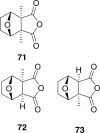Drug Discovery Insights from Medicinal Beetles in Traditional Chinese Medicine
- PMID: 33632986
- PMCID: PMC7921859
- DOI: 10.4062/biomolther.2020.229
Drug Discovery Insights from Medicinal Beetles in Traditional Chinese Medicine
Abstract
Traditional Chinese medicine (TCM) was the primary source of medical treatment for the people inhabiting East Asia for thousands of years. These ancient practices have incorporated a wide variety of materia medica including plants, animals and minerals. As modern sciences, including natural products chemistry, emerged, there became increasing efforts to explore the chemistry of this materia medica to find molecules responsible for their traditional use. Insects, including beetles have played an important role in TCM. In our survey of texts and review articles on TCM materia medica, we found 48 species of beetles from 34 genera in 14 different families that are used in TCM. This review covers the chemistry known from the beetles used in TCM, or in cases where a species used in these practices has not been chemically studied, we discuss the chemistry of closely related beetles. We also found several documented uses of beetles in Traditional Korean Medicine (TKM), and included them where appropriate. There are 129 chemical constituents of beetles discussed.
Keywords: Beetle; Chemical defense; Coleoptera; Secondary metabolites; Traditional Chinese Medicine; Traditional Korean Medicine.
Conflict of interest statement
The authors declare no competing interest.
Figures




















Similar articles
-
An investigation of the pharmacological applications used for the Ancient Egyptian systemic model 'ra-ib' compared with modern Traditional Chinese Medicine.J Ethnopharmacol. 2021 Jan 30;265:113115. doi: 10.1016/j.jep.2020.113115. Epub 2020 Sep 3. J Ethnopharmacol. 2021. PMID: 32891812
-
[Geographical views in traditional Chinese medicine].Zhongguo Zhong Yao Za Zhi. 2022 Dec;47(23):6287-6296. doi: 10.19540/j.cnki.cjcmm.20220624.101. Zhongguo Zhong Yao Za Zhi. 2022. PMID: 36604873 Chinese.
-
[Species of Chinese materia medica resources based on the fourth national survey of Chinese materia medica resources].Zhongguo Zhong Yao Za Zhi. 2024 Jul;49(13):3409-3413. doi: 10.19540/j.cnki.cjcmm.20240516.101. Zhongguo Zhong Yao Za Zhi. 2024. PMID: 39041112 Chinese.
-
Future development of global regulations of Chinese herbal products.J Ethnopharmacol. 2012 Apr 10;140(3):568-86. doi: 10.1016/j.jep.2012.02.029. Epub 2012 Feb 25. J Ethnopharmacol. 2012. PMID: 22373513 Review.
-
[Research,evaluation,industry status and development strategy of traditional Chinese medicine functional food].Zhongguo Zhong Yao Za Zhi. 2019 Mar;44(5):861-864. doi: 10.19540/j.cnki.cjcmm.20190115.006. Zhongguo Zhong Yao Za Zhi. 2019. PMID: 30989840 Review. Chinese.
Cited by
-
Chondroprotective effects of Protaetia brevitarsis seulensis larvae as an edible insect on osteoarthritis in mice.Food Sci Nutr. 2023 Oct 6;11(12):7887-7899. doi: 10.1002/fsn3.3706. eCollection 2023 Dec. Food Sci Nutr. 2023. PMID: 38107146 Free PMC article.
-
Huangtu decoction alleviates chronic diarrhea of spleen-yang deficiency in mice by altering host metabolome and intestinal microbiota composition.Am J Transl Res. 2024 Jun 15;16(6):2248-2262. doi: 10.62347/IHNX2675. eCollection 2024. Am J Transl Res. 2024. PMID: 39006272 Free PMC article.
-
Innovative Application of Medicinal Insects: Employing UHPLC-MS, Bioinformatics, In Silico Studies and In Vitro Experiments to Elucidate the Multi-Target Hemostatic Mechanism of Glenea cantor (Coleoptera: Cerambycidae) Charcoal-Based Medicine.Pharmaceuticals (Basel). 2025 Mar 27;18(4):479. doi: 10.3390/ph18040479. Pharmaceuticals (Basel). 2025. PMID: 40283916 Free PMC article.
-
Antiparasitic Effects of Potentially Toxic Beetles (Tenebrionidae and Meloidae) from Steppe Zones.Toxins (Basel). 2021 Jul 14;13(7):489. doi: 10.3390/toxins13070489. Toxins (Basel). 2021. PMID: 34357960 Free PMC article.
-
Atomic structure of a nudivirus occlusion body protein determined from a 70-year-old crystal sample.Nat Commun. 2023 Jul 13;14(1):4160. doi: 10.1038/s41467-023-39819-1. Nat Commun. 2023. PMID: 37443157 Free PMC article.
References
-
- Allison J. D., Borden J. H., Seybold S. J. A review of the chemical ecology of the Cerambycidae (Coleoptera) Chemoecology. 2004;14:123–150. doi: 10.1007/s00049-004-0277-1. - DOI
-
- Altson A. M. On the genital system of Lyctus brunneus Steph., with a note on Lyctus linearis Goeze (Coleoptera) Zool. J. Linn. Soc. 1924;35:581–597. doi: 10.1111/j.1096-3642.1924.tb00056.x. - DOI
Publication types
LinkOut - more resources
Full Text Sources
Other Literature Sources
Research Materials

